Your cart is currently empty!
Red Columbine is a Wonderful Woodland Flower
Red columbine is a beautiful woodland wildflower that has showy, drooping, bell-like flowers which attract pollinators.
Your cart is currently empty!
Photo:
Jean Carr
Text and photos are courtesy of the Vallarta Botanical Garden.
Did you know Vanilla plant is an orchid?
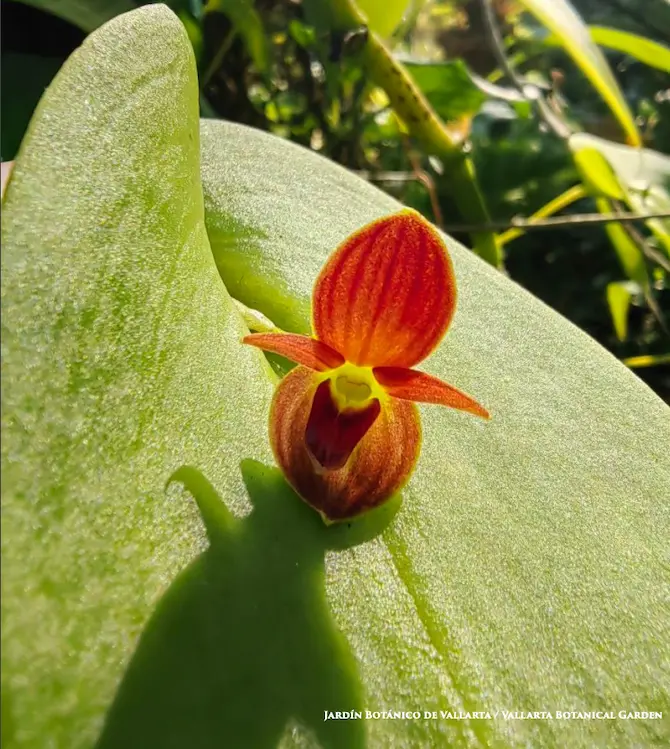
The collections of our botanical garden hold a great diversity of orchids with large and showy flowers, but when you visit us, remember to pay attention to the small details, because some orchids produce flowers so tiny that they can go unnoticed even by people passing by.
One example is this month’s orchid: Pleurothalis cardiothallis, whose flowers measure 1.5 centimeters and appear to emerge from the middle of a leaf, although they actually emerge from a short stem that is surrounded by the leaf. This beautiful plant is native to the jungles of Mesoamerica and grows on top of trees, without parasitizing them or penetrating their tissues, that is, it is epiphytic.
Authored by Dr. Cristóbal Sánchez.
This month we will have the opportunity to marvel at the fabulous flowering of Epidendrum citrosmum, an orchid native to Mexico whose scientific name, as you will see, refers to its distinctive characteristics.
In the American Continent there are about a thousand species of the genus Epidendrum, a name that comes from the Greek “epi” = “on top” and “dendron” = “tree”, and refers to the epiphytic habit of these orchids, that is, they live on top of trunks, without parasitizing them. On the other hand, in the epithet citrosum: “kitros” refers to citrus fruits and “osme” = “smell”, due to the nocturnal soft citrus aroma of the greenish flowers.
If you visit us this season you will be able to find many Epidendron and other epiphytic orchids in full bloom. You cannot miss them!
Authored by Dr. Cristóbal Sánchez.
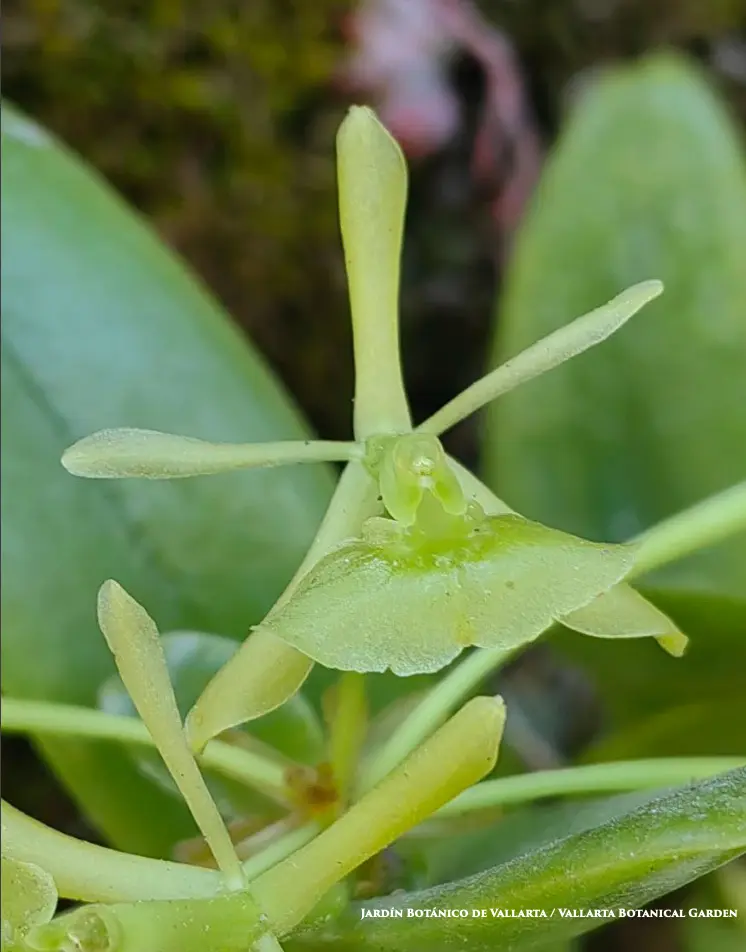
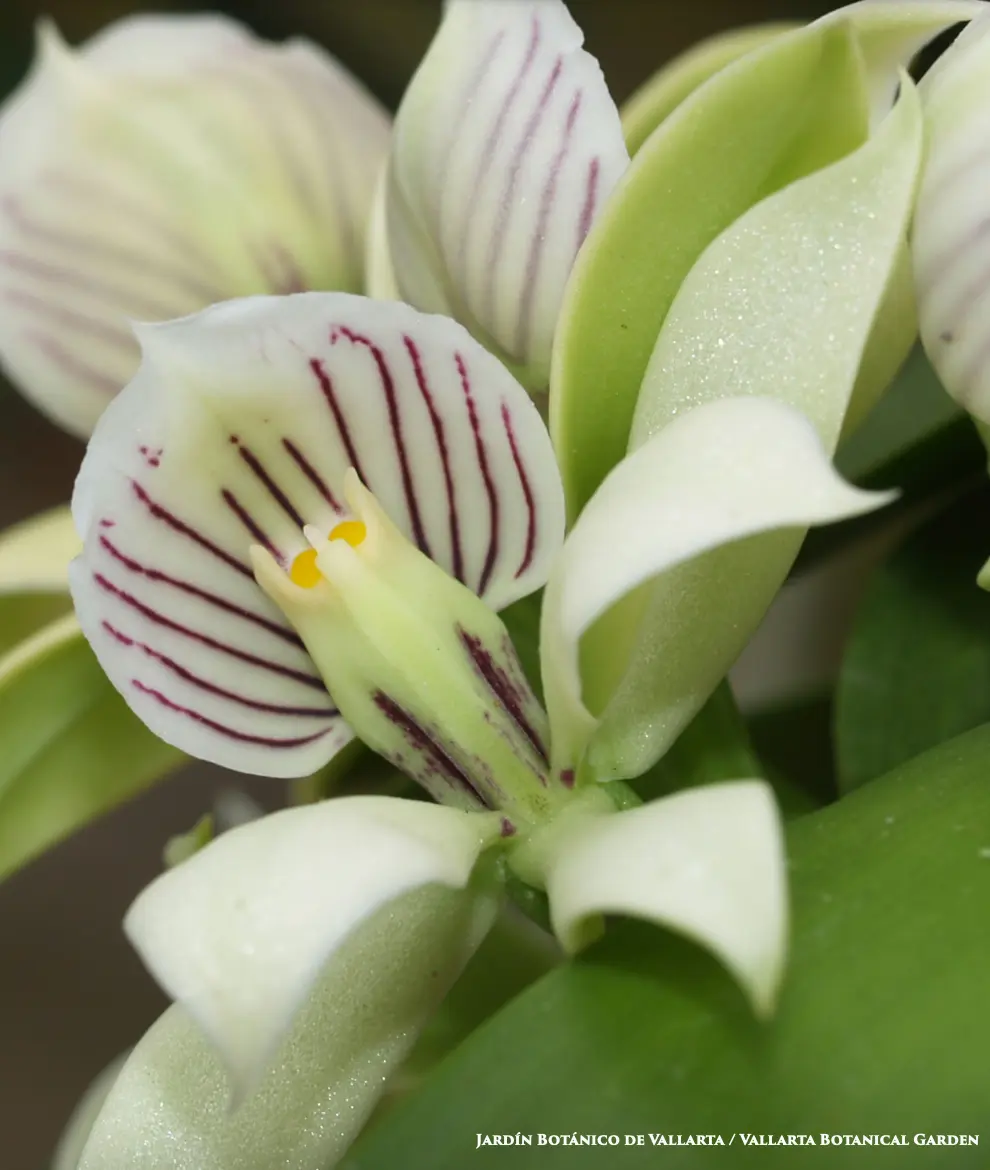
The New World tropical epiphytic orchid Prosthechea trulla is often confused with Prosthechea cochleate. They are similar in look, but P. trulla has a narrower lip (9-17 mm wide and 9-12 mm long) with a trowel shape, whereas the lip of P. cochleata is broader (13-26 mm wide and 10-21 mm long) and the sepals and petals of P. cochleata are longer (30-75 mm in length) than those of P. trulla. P. trulla is an endemic species found in oak or pine-oak forests and occasionally on rocks at elevations of 300 to 1500 meters.
It is a small to medium sized, hot to cool growing epiphyte and occasional lithophyte with loosely clustered, pyriform (pear shape) to ellipsoid, laterally compressed pseudobulbs carrying 2, apical, acute, narrowly elliptic leaves that blooms at most any time of the year on a racemose, 4 to 10 flowered inflorescences. The flowers grow about 3 cm.
— Information provided by Jay Pfahl, author of the Internet Orchid Species Encyclopedia (IOSPE).
By Biologist Leonardo Campos
Myrmecophila galeottiana is an orchid endemic to Mexico with beautiful, lightly scented pink flowers with a unique interaction with ants.
The bulbs of this orchid are hollow, which is convenient for the ant as it finds a comfortable home in them, while the orchid benefits from having a fierce guardian to protect it.
Remember, when you come across a Purple Ant Orchid, take precautions; its little guardians are always on the lookout!
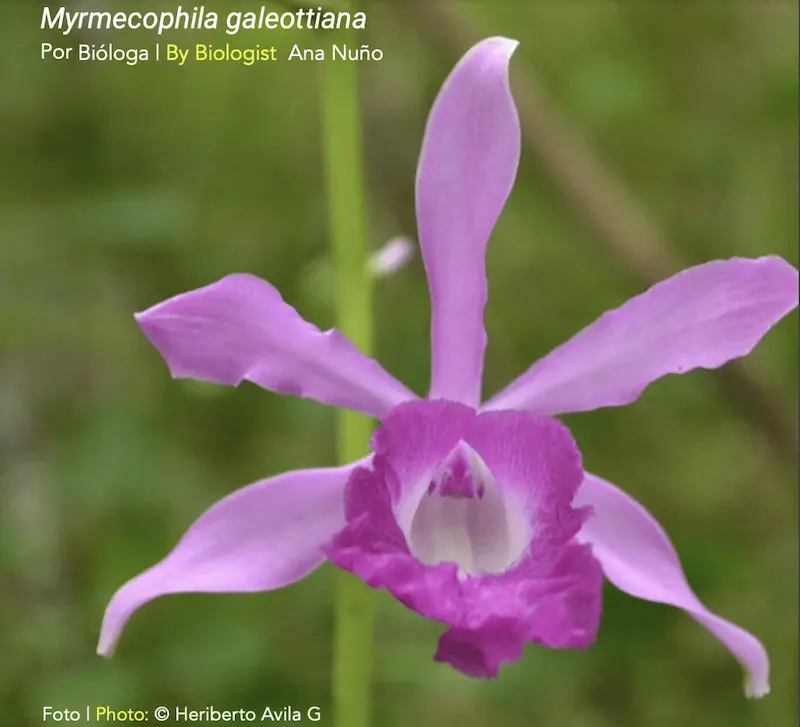
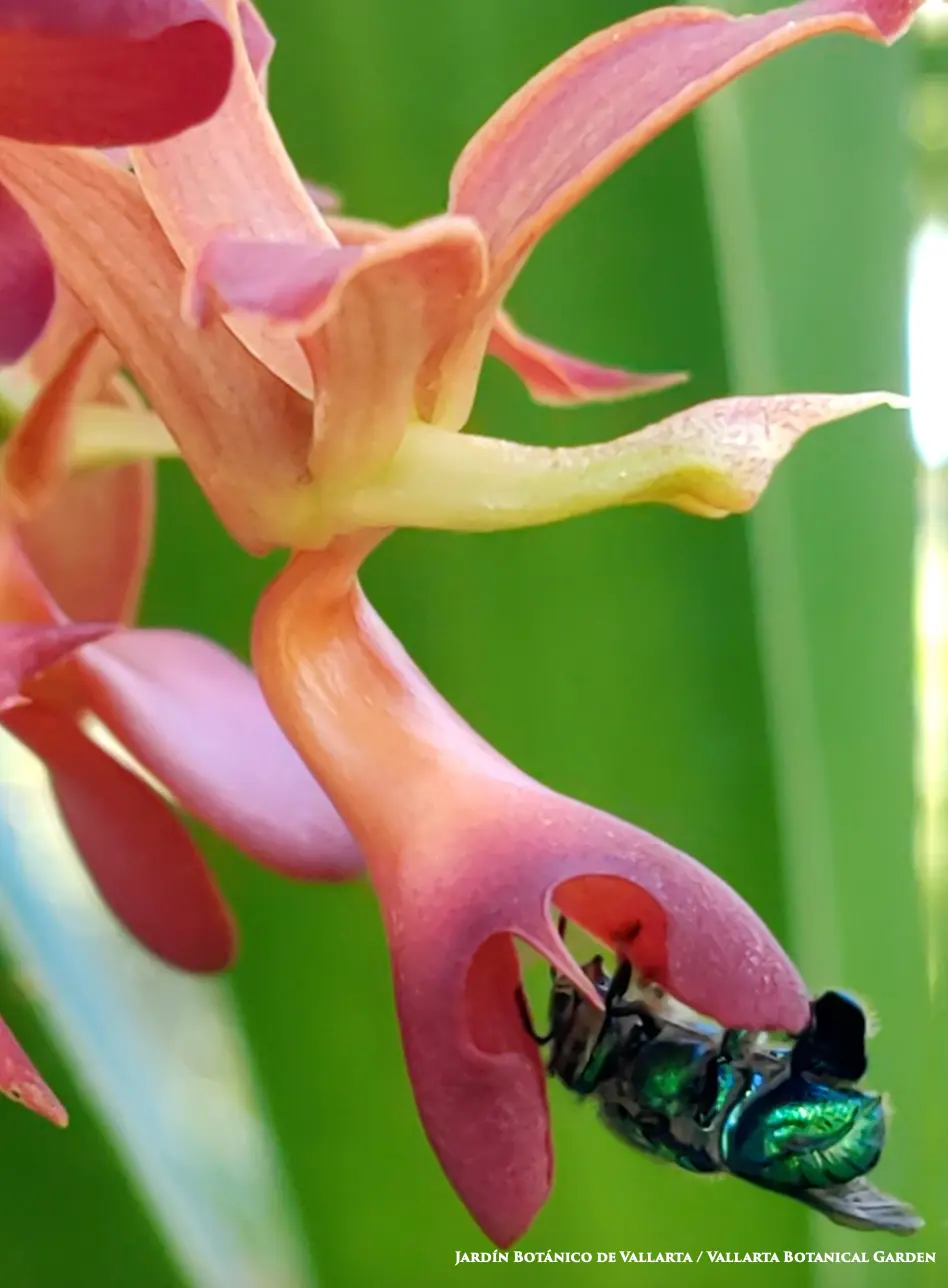
Mormodes badia thrives in the wild only on the bark of oaks and semi-deciduous forests of the coastal regions of Nayarit and Jalisco. Autumn heralds the yellowing of its leaves, which fall entirely and give way to a beautiful and exciting bloom. This orchid can present various colorations in its flowers, from yellow to orange, brown, or even red.
While these flowers open their tepals, the courtship of metallic bees of the genus Euglossine takes place. The males are known for collecting scents from many flowers to seduce the females, so during this perfume competition, they must include the irresistible fragrance of this endemic orchid.
This is an image of the incredible interaction you can observe in our garden during this season. Come and appreciate the beauty with us and learn about this Mexican orchid’s importance.
By Doctor. Cristóbal Sánchez
Bletia roezlii or Coral orchid is a terrestrial plant species distributed from Mexico to Central America. Its beautiful green flower with a spectacular labellum featuring a callus and several ridges with red stripes adorns forests almost from sea level to 2700 m.
Coral orchids are annual plants with subterranean pseudobulbs and several nodes. We can enjoy their beautiful flowers between spring and summer. If you go to the forest in those dates, open your eyeswide, maybe you can see a Coral orchid.
By Biologist Ana Nuño
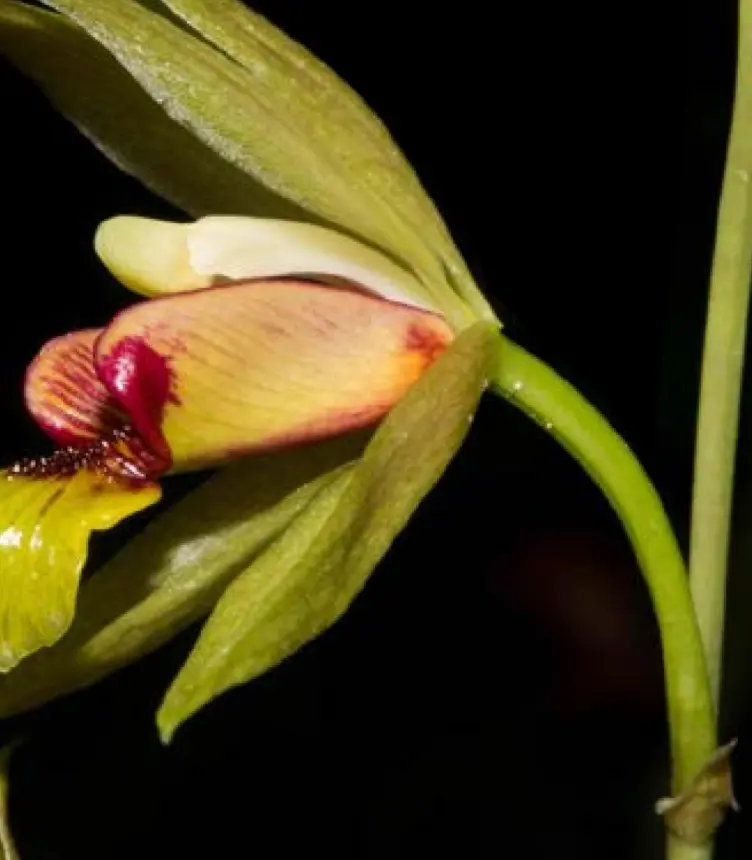
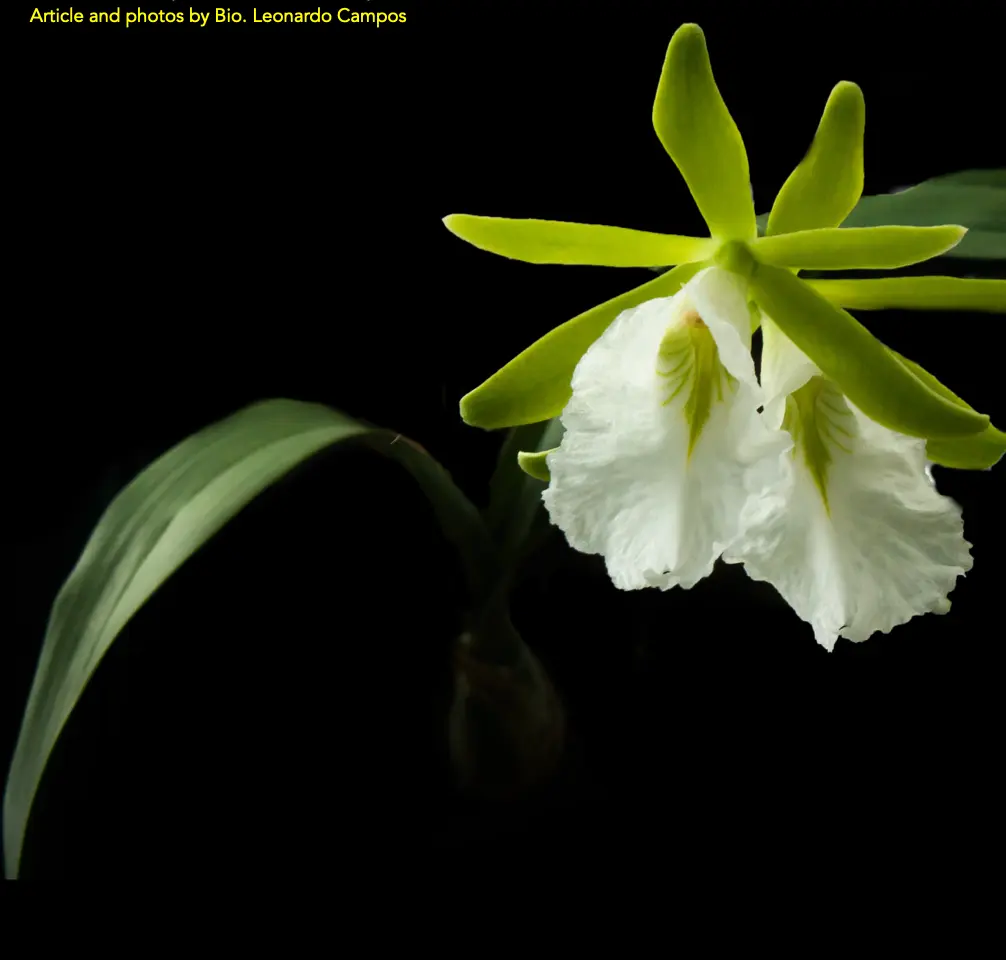
By W.E. Higgins
Prosthechea mariae is one of the most well-known species of Mexican orchids in horticulture. It ́s widely cultivated in Mexico and abroad and has been the progenitor to many hybrids of Cattleya alliance.
Its distribution occurs only in temperate, semi-humid climates with summer rains, in the Sierra Madre Oriental of San Luis Potosí and Tamaulipas. It also has climatological requirements and its altitudinal range is narrow.
This species of orchid is epiphytic and usually found on tree trunks or high branches of oak trees, frequently presenting thin layers of moss. Be that as it may, Prosthechea mariae is extremely easy to cultivate and is tolerant to many cultural conditions. Its best performance is achieved in conditions similar to those of its habitat, but it can be cultivated in greenhouse conditions, and has been able to remain several years close to sea level, in fairly warm conditions.
The month of October has one of the most awaited Mexican traditions of the whole year: the Day of the Dead. This Mexican orchid, the beautiful Bletia campanulata, is better known by its common name, “Flower of the Dead.”
Bletia campanulata is distributed from central Mexico to western Argentina and can be found growing mainly in volcanic rocks in thickets and in oak or conifer forests from 1500 to 2100 meters of altitude.
Its flower is approximately 50 cm tall and has a red- purple color on the edges and white in the center. It can have from 2 to 5 flowers per plant.
A characteristic that distinguishes this species from the previous orchids of the month, is its terrestrial habit, compared to the previous ones that had an epiphyte habit. In other words, this orchid grows directly on the ground, while the orchids chosen on previous months grew on top of other plants or on top of surfaces.
Its scientific name refers to the Spanish apothecary Luis Blet, as well as to the bell shape of its flower.
Bletia campanulata was first described in 1825 by Juan José Martínez de Lexarza.
By Emiliano Padilla
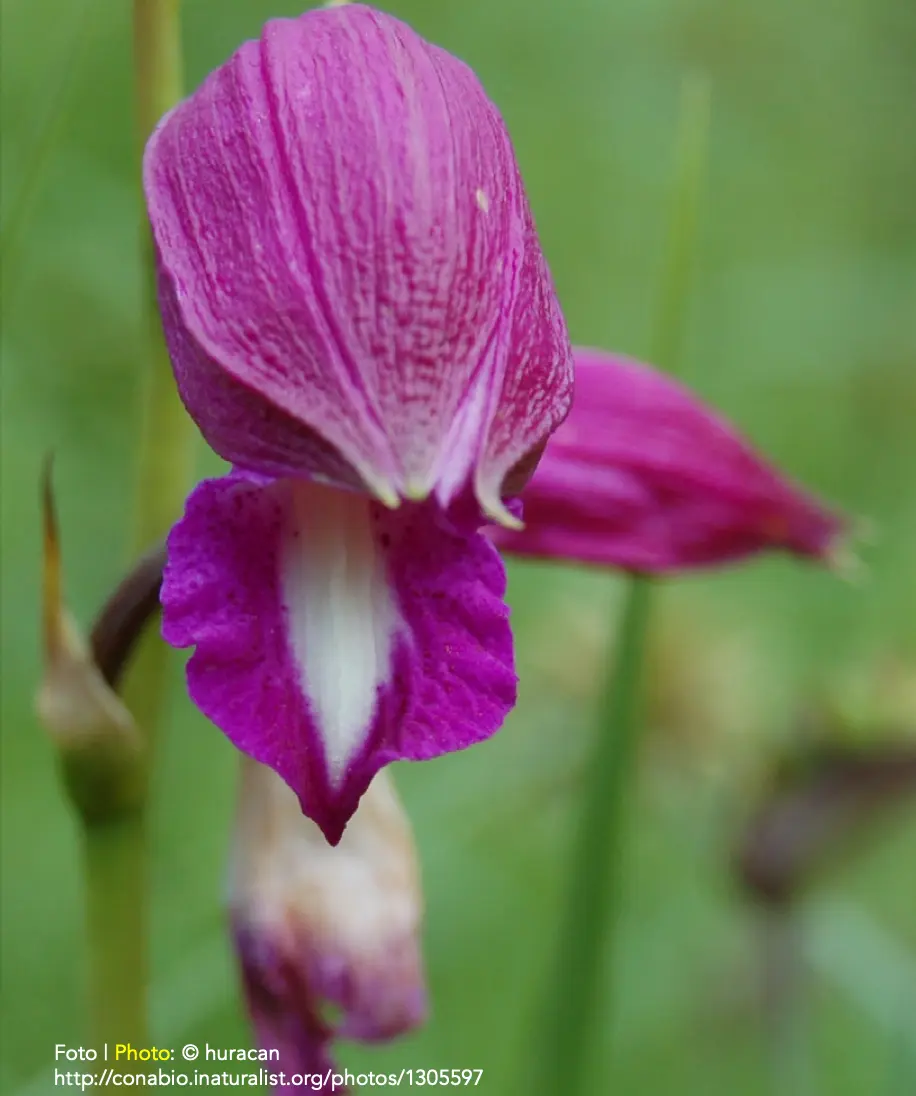
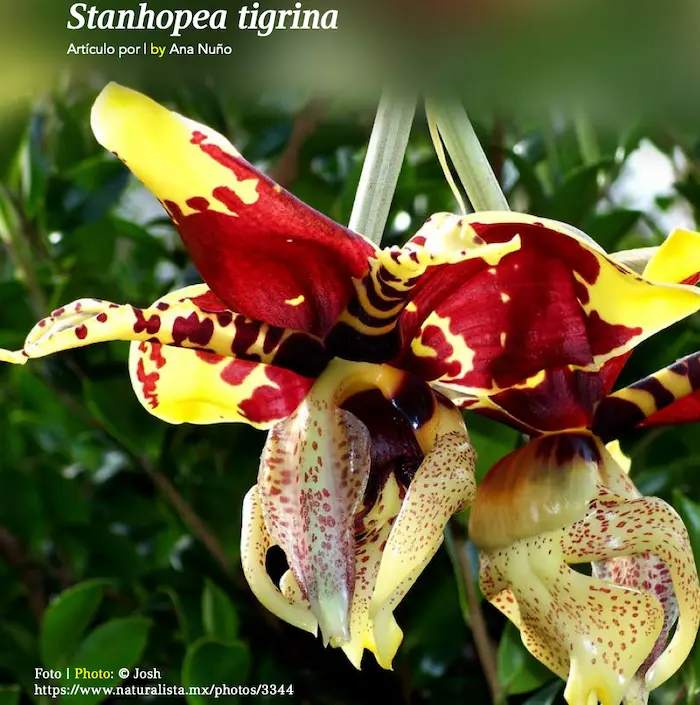
The orchid Stanhopea tigrina or “Cabeza de Vibora” is an epiphytic plant endemic to Mexico, it is also known as “Calavera” (Mexico-Queretaro), “Tecuán morado” (Mexico), “Torito” (Mexico-Puebla), “Torito negro” (Mexico-Veracruz) and “Vaquita” (Mexico-Veracruz).
This rare orchid graces the temperate and tropical forests of the Sierra Madre Oriental, being one of the most beautiful orchids in Mexico. Its flower is creamy with large purple spots, its appearance is waxy and sticky to the touch, it gives off an aphrodisiac scent and very attractive to its pollinator. Bees of the Euglossa genus are in charge of pollination when the “Cabeza de Vibora” displays its flowers in July and August.
Many orchid species are highly valued around the world for their attractive flowers, and this one is no exception. Stanhopea tigrina is distinguished mainly for its ornamental form thanks to the uniqueness and beauty of its flowers and their intoxicating aroma.
Pre-Hispanic cultures in Mexico used the flowers to treat sunstroke and weakness, likewise, the flowers were incorporated into the nixtamal (corn treated with lime to make tortillas) so that they would give the tortillas their particular aroma.
Click throught for advice on how to care for Orchids
Red columbine is a beautiful woodland wildflower that has showy, drooping, bell-like flowers which attract pollinators.
We share the many benefits children gain from gardening, along with some clever independent plant and gardening ideas for children.
Protect your family and pets from dangerous plants. Learn the names of poisonous plants and take necessary safety steps to prevent accidental poisoning.
Get ready for winter in your Ottawa garden! Pruning, fertilizing, watering, and planting are the tasks of the day. Plant spring bulbs, fall-flowering annuals, and divide perennials to add color until October. Don't forget to dig and store dahlias, cannas and more. Time to get pruning!
Discover the allure of forget me not flowers, whether as annuals or perennials. Perfect for gardeners wanting dainty, heavenly blooms. Buy or grow seeds!
Softened water can be severely damaging to plants. Using softened water should be done in a controlled manner, and avoided whenever possible.
GardeningCalendar.ca gets some funding from advertisers. If you click on links and advertisements at no cost to you, the site may receive a small commission that helps fund its operation.
© 2025 J&S Calendars Ltd.
Leave a Reply
You must be logged in to post a comment.